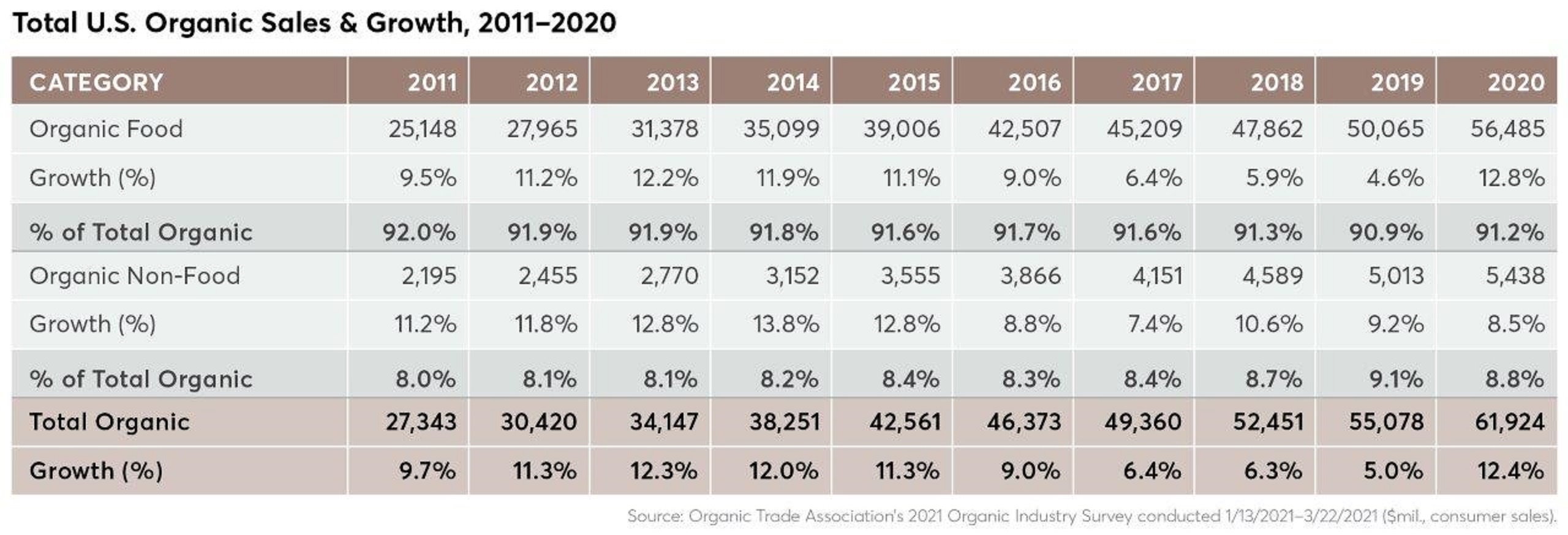Organic Trade Association survey says swing to home cooking in pandemic ignited sales
U.S. organic sales soared to new highs in 2020, jumping by a record 12.4 percent to $61.9 billion. It marked the first time that total sales of organic food and non-food products have surpassed the $60 billion mark, and reflected a growth rate more than twice the 2019 pace of 5 percent, according to the 2021 Organic Industry Survey released recently by the Organic Trade Association. Overall, organic food sales have increased from $25 billion in 2011 to $56 billion in 2020, a 124% increase.
Black beans, flour, and chicken broth are not typically out of stock. They were in 2020. In that unprecedented year, organic’s reputation of being better for you and the planet positioned it for dramatic growth. In almost every organic food aisle, demand jumped by near-record levels, propelling U.S. organic food sales in 2020 up a record 12.8 percent to a new high of $56.4 billion. In 2020, almost 6 percent of the food sold in the United States was certified organic.
The COVID-19 pandemic caused consumer dollars to shift almost overnight from restaurants and carry-out to groceries, with traditional staples and pantry and freezer items flying off the shelves. Consumer habits were upended, online grocery shopping and grocery deliveries exploded, and new products were tried as families ate three meals a day at home.
A September 2020 article in The Organic & Non-GMO Report described how sales of organic foods were strong during the COVID-19 pandemic according to executives at several organic food companies.
“The pandemic caused abrupt changes in all of our lives. We’ve been eating at home with our families, and often cooking three meals a day. Good, healthy food has never been more important, and consumers have increasingly sought out the Organic label. Organic purchases have skyrocketed as shoppers choose high-quality organic to feed and nourish their families,” said Laura Batcha, CEO and executive director of the Organic Trade Association. Batcha announced the new data recently at Organic Day at Natural Products Expo West.
Stocking the pantry, refrigerator and freezer with organic
Leading the charge for healthy food was the desire for fresh produce. Fresh organic produce sales rose by nearly 11 percent in 2020 to sales of $18.2 million. Frozen and canned fruits and vegetables also jumped with frozen sales alone rising by more than 28 percent. Including frozen, canned, and dried products, total sales of organic fruit and vegetables in 2020 were $20.4 billion. More than 15 percent of the fruits and vegetables sold in this country now are organic.
Pantry stocking was overwhelmingly the main growth driver in 2020. As bread making and cookie baking took kitchens across the country by storm, sales of organic flours and baked goods grew by 30 percent.
Consumers also turned to “meal support” products to help them in the kitchen. Sales of sauces and spices pushed the $2.4 billion condiments category to a growth rate of 31 percent, and organic spice sales jumped by 51 percent, more than triple the growth rate of 15 percent in 2019.
Meat, poultry, and fish, the smallest of the organic categories at $1.7 billion, had the second highest growth rate of nearly 25 percent.
Steady growth in non-food sector
The organic non-food category did not see the same exceptional growth in 2020 as organic food, but its growth held steady with prior years. Sales of organic non-food products reached $5.4 billion, up 8.5 percent and only slightly below the 9.2 percent reported in 2019.
Reflecting the pandemic and as in the conventional market, organic sales were driven by personal hygiene, hand sanitizers and cleaning products. Sales of organic household products saw record growth of 20 percent.
Textiles and fibers, the biggest category of the organic non-food sector, saw sales slow as stores closed, and clothes buying dipped. That said, the category fared better than expected given its ties to brick-and-mortar retail and the shutdown of that sales channel for a significant period of time. For the year, U.S. organic fiber (linens, clothing and other textiles) sales grew at a rate of 5 percent, compared to 12 percent in 2019, reaching sales of $2.1 billion.
What’s ahead in the “new normal”
While the growth in organic food sales is not expected to continue at 2020’s fast rate, organic food sales are expected to stay on a strong growth path in 2021. It’s anticipated that the grocery industry at large will get a lasting lift from the pandemic for the foreseeable future as many consumers continue to cook more at home.
“We’ve seen a great many changes during the pandemic, and some of them are here to stay,” said Batcha. “What’s come out of COVID is a renewed awareness of the importance of maintaining our health, and the important role of nutritious food. For more and more consumers, that means organic. We’ll be eating in restaurants again, but many of us will also be eating and cooking more at home. We’ll see more organic everywhere—in the stores and on our plates.”
This year’s survey was conducted from January through March 2021 and was produced on behalf of the Organic Trade Association by Nutrition Business Journal (NBJ). Nearly 200 companies completed a significant portion of the in-depth survey. Executive summaries of the survey are available to the media upon request. The full report can be purchased; online orders can be placed on this page.
Source: Organic Trade Association
To view source article, visit: https://ota.com/news/press-releases/21755
Organic & Non-GMO Insights June 2021









